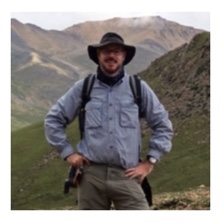Gregory Okin

Focuses upon geomorphic processes upon arid and semiarid landscapes including desertification, wind erosion, nutrient cycles, and other processes. His main research themes are aeolian geomorphology and desert ecosystems via the interaction of climate, vegetation, and soil. Photo credit: https://geog.ucla.edu/person/gregory-okin/ Research info source: http://www.sscnet.ucla.edu/geog/faculty/okin/Gregory_S_Okin/Research.html
I find his work interesting due to having worked as an assistant on a research project focused on agroecology and soil science my freshman year. Part of this included having to build a literature database where I read a lot of scientific literature on climate change, ecology, soil processes, and agriculture with many of them focusing on changes in vegetation cover or climate including desertification.
LI, J., Okin, G. S., Alvarez, L. & Epstein, H. (2007). Quantitative effects of vegetation cover on wind erosion and soil nutrient loss in a desert grassland of southern New Mexico, USA. Biogeochemistry, 85, 317-332. https://doi.org/10.1007/s10533-007-9142-y
Examines how vegetation cover impacts wind erosion severity and soil nutrient loss within a desert ecosystem. Plots of different vegetation cover levels were created in a location with low invasive honey mesquite levels to focus upon grasslands cover impacts. Precipitation was measured to monitor climate impacts upon erosion levels. Wind erosion was calculated using horizontal mass fluxes and soil nutrient loss was calculated as nutrient concentrations through soil sample extractions. Flux rates showed a nonlinear relationship between decreasing vegetation cover and increasing wind erosion rates with the highest rates in the spring. The plots with the highest grass cover removal treatments had the most soil nutrient loss with a potential threshold between 25-50% vegetation cover loss. Results suggest that lateral cover is more effective than fractional cover at reducing wind erosion and that mesquite leads to higher erosion rates than grasslands. Organic carbon and nitrogen loss accounted for the majority of soil nutrient loss with the threshold of vegetation cover impacting nutrient gain versus loss.
Okin, G.S., Parsons, A. J., Wainwright, J., Herrick, J., Bestelmeyer, B. T., Peters, J.C. & Fredrickson, E. L. (2009). Do Changes in Connectivity Explain Desertification? BioScience, 59(3), 237-244. https://doi.org/10.1525/bio.2009.59.3.8
Desertification- the degradation of semiarid and arid landscapes- via diverse forms without a unifying framework. Landscape connectivity is the main concept to understand desertification. Speculation upon length of a pathway required for reaching the threshold to start cascading processes on landscapes. Extreme events can cause paths to coalesce allow short pathways to lengthen into long pathways that are limited in further lengthening to long timescale changes. Transported material reaching the end of the pathway can trigger positive feedback loops that lengthen the pathways. These changes increase pathways from local to regional scales causing greater landscape impacts. Better protocols are required to monitor degradation from connectivity changes to identify potential spread of desertification and sources of remediation.